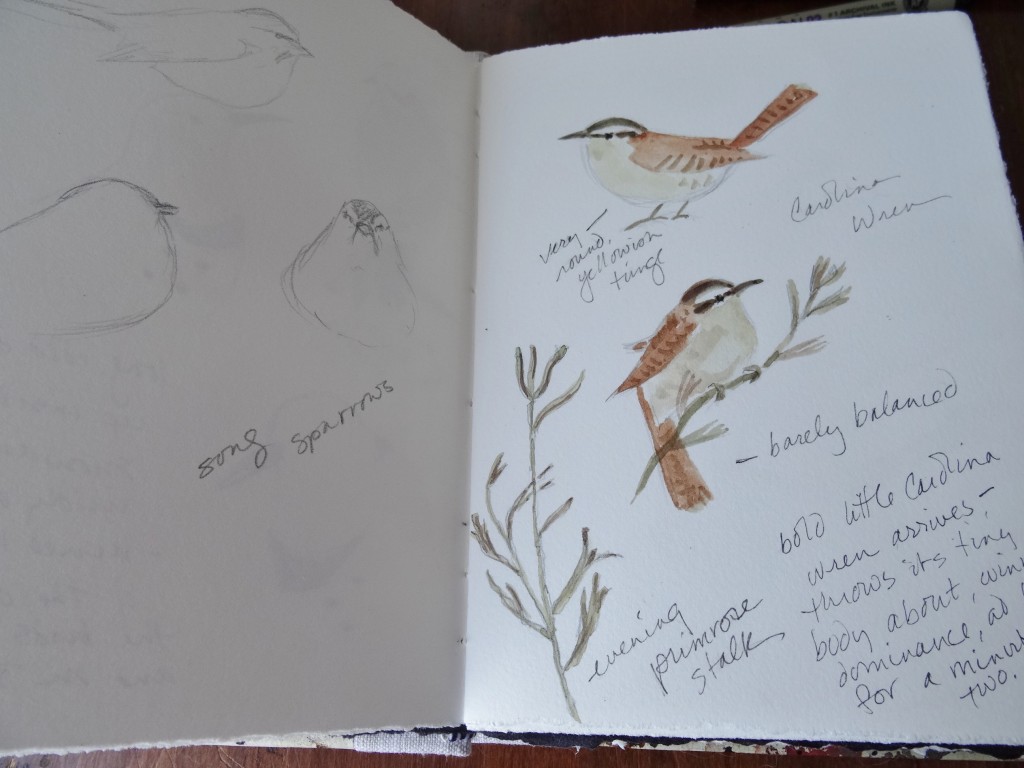This past weekend I was at Mass Audubon’s Wellfleet Bay Wildlife Sanctuary to teach an intensive two day Field School focusing on Field Sketching for Birders. I never know who will sign up for such a class or what their expectations will be so it is always a bit of a challenge setting up the schedule.
Drawing birds seems like a simple thing but it is actually quite challenging to get them right.
 The weather forecast was for rain and cold wind for both days which made it difficult to work outside. The first day we worked indoors but we did manage to get out several times on Sunday.
The weather forecast was for rain and cold wind for both days which made it difficult to work outside. The first day we worked indoors but we did manage to get out several times on Sunday.
In the classroom we began by drawing bird shapes from memory and then worked on drawing bird silhouettes, as correct shape and form is important for bird identification. The students had different goals and different levels of ability but this exercise went well for all.
 We worked on drawings of bills and feet, bird anatomy and then from bird pictures in field guides before venturing out to the feeder area. Drawing live birds is quite a challenge but these folks were up to it! They worked very hard and although the birds were in constant motion the sketchers were able to pin down characteristic moves and postures.
We worked on drawings of bills and feet, bird anatomy and then from bird pictures in field guides before venturing out to the feeder area. Drawing live birds is quite a challenge but these folks were up to it! They worked very hard and although the birds were in constant motion the sketchers were able to pin down characteristic moves and postures.
 At 7 a.m. on Sunday we headed out in a cold drizzle to see what we could see for birds with naturalist and birder, David Clapp. A great egret was a highlight as were several green winged teal in Goose Pond. The rain got heavier and we returned to the classroom where Melissa had prepared a wonderful hearty continental breakfast for us. Warm beverages were especially appreciated.
At 7 a.m. on Sunday we headed out in a cold drizzle to see what we could see for birds with naturalist and birder, David Clapp. A great egret was a highlight as were several green winged teal in Goose Pond. The rain got heavier and we returned to the classroom where Melissa had prepared a wonderful hearty continental breakfast for us. Warm beverages were especially appreciated.
 We drew from feathers and from the bird mounts in the WBWS collection. We returned to the feeders but also worked on bills and feet from the mounted hawks and songbirds on display in the exhibit area.
We drew from feathers and from the bird mounts in the WBWS collection. We returned to the feeders but also worked on bills and feet from the mounted hawks and songbirds on display in the exhibit area.
All this drawing was pretty intense and some people began to fade. Unless you’ve actually sat or stood and drawn something for almost 8 hours it is hard to describe the concentration and attention required and how tiring it can be. Also, drawing small moving targets can be frustrating. And yet, the students put on their brave faces and kept on drawing. I was impressed with their attitudes and their willingness to really work hard. Their drawings were impressive, even if some of them were frustrated by the results of their own labors. This is not easy stuff! They did great.
At one point one of the students mentioned she and her mother had seen a nest on the ground with a broken egg. She thought the nest was woven into the grass. I was curious and she took me out to see it. I photographed it as well as drew it and showed it to the bird experts when we returned to the building. After some discussion it was decided it was….
 a woodcock nest! It had not survived a predator attack but it was still cool to see such a thing. I brought all the students out to see it and it made a nice little finish to the workshop.
a woodcock nest! It had not survived a predator attack but it was still cool to see such a thing. I brought all the students out to see it and it made a nice little finish to the workshop.
My next field school session will be in July and will be Nature Sketching for Scaredy Cats.






